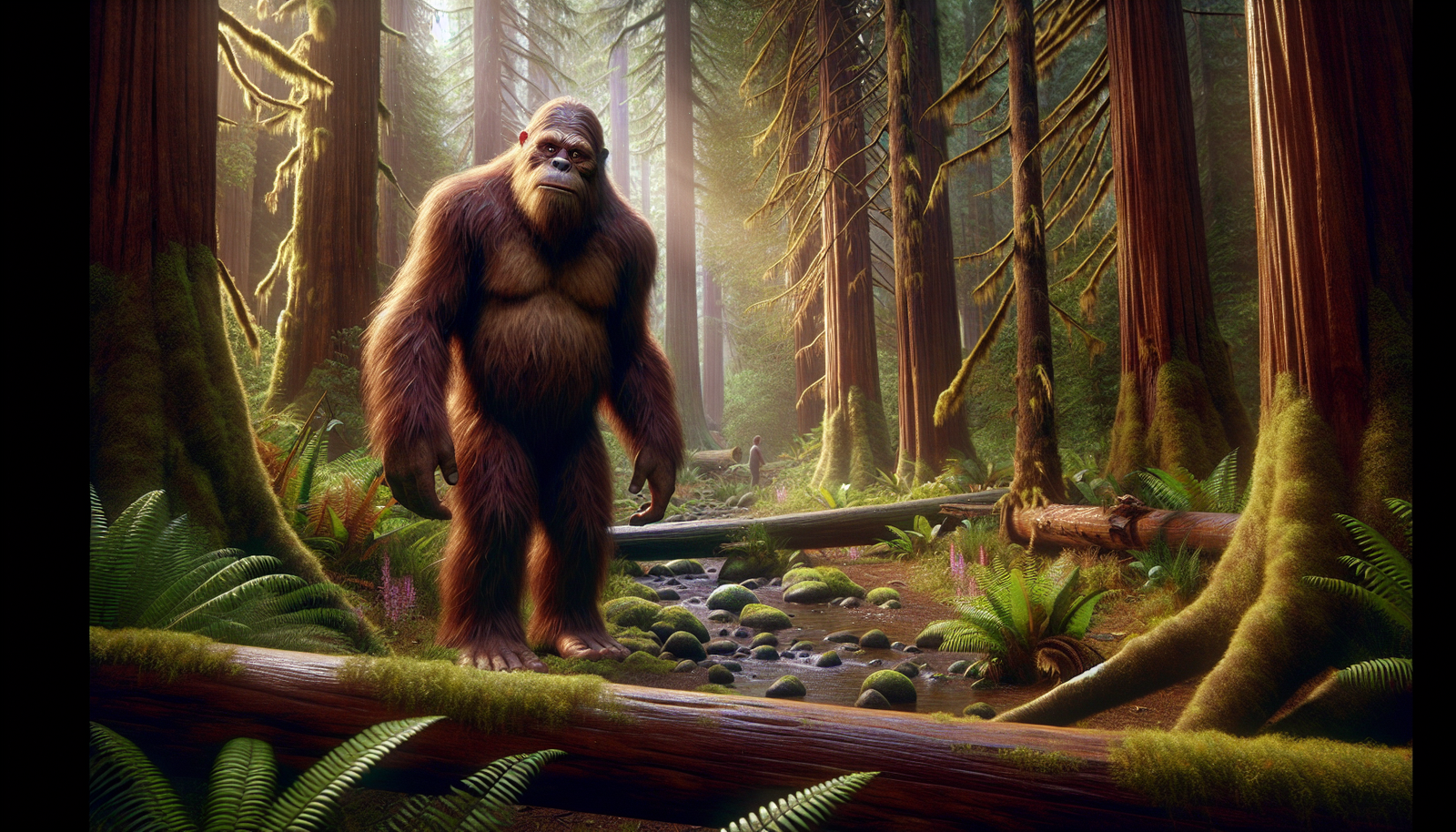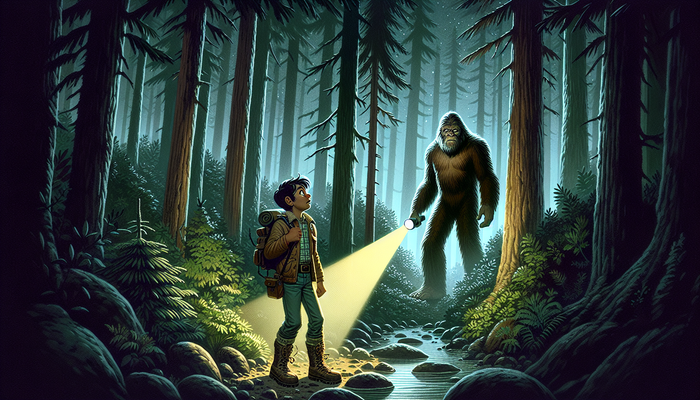Exploring Bigfoot and Forest Ecosystems: Myths, Habitats, and Conservation

By James Roberts, Cryptozoologist
The Legend of Bigfoot: A Tapestry of Myth and Culture
The story of Bigfoot is as old as the forests themselves, woven into the fabric of North American culture long before the first European settlers set foot on the continent. Indigenous peoples across the land have passed down tales of large, hairy, human-like creatures for countless generations. These stories, far from being mere entertainment, often served as cautionary tales or lessons about respecting nature and its mysteries.
Take, for instance, the Salish people of the Pacific Northwest. Their legends speak of the Sasquatch, a name that would later be adopted by the wider world. To the Salish, the Sasquatch was more than just a wild man of the woods; it was a spiritual being, a guardian of the natural world. This concept of Bigfoot as a protector of the wilderness is a recurring theme in many Indigenous stories, reflecting a deep-rooted respect for the balance of nature.
As European settlers pushed westward, these ancient stories began to mingle with their own folklore traditions. The concept of the "wild man" was not unfamiliar to European cultures, with tales of hairy forest dwellers appearing in medieval literature and art. This cultural collision gave birth to a new iteration of the Bigfoot legend, one that would capture the American imagination for centuries to come.
The Modern Era of Bigfoot Lore
The modern era of Bigfoot lore can be traced back to the mid-20th century, with a series of high-profile sightings and alleged evidence that thrust the creature into the national spotlight. In 1958, Jerry Crew, a bulldozer operator in Bluff Creek, California, made plaster casts of enormous footprints he claimed to have found at his worksite. The story made headlines across the country, and the term "Bigfoot" entered the popular lexicon.
But it was the Patterson-Gimlin film of 1967 that truly cemented Bigfoot's place in American culture. This short piece of footage, purportedly showing a large, hair-covered bipedal creature walking along a creek bed, has been the subject of intense scrutiny and debate for over half a century. Despite numerous attempts to debunk it, the film remains the most famous and controversial piece of evidence in the Bigfoot canon.
These events marked a turning point in the Bigfoot narrative. What was once a collection of local legends and campfire stories became a national phenomenon, spawning countless books, documentaries, and even academic studies. The search for Bigfoot evolved into a subculture of its own, with dedicated researchers and enthusiasts devoting their lives to uncovering the truth behind the myth.
Bigfoot in Popular Culture
The cultural impact of Bigfoot extends far beyond the realm of cryptozoology. The creature has become a powerful symbol in popular culture, appearing in everything from serious documentaries to comedic films and advertising campaigns. This widespread recognition has, in turn, influenced how we think about wilderness and conservation.
The idea of Bigfoot roaming the forests has instilled a sense of wonder and mystery in many people's perception of wild places. It's a reminder that there are still corners of our world that remain unexplored, still secrets that nature has yet to reveal. This sense of possibility has inspired many to venture into the wilderness, fostering a connection with nature that might otherwise have remained dormant.
Bigfoot and Conservation
Moreover, the Bigfoot legend has become intertwined with environmental advocacy in surprising ways. Many Bigfoot researchers and enthusiasts have become passionate advocates for forest conservation, arguing that protecting these habitats is crucial not only for the potential existence of Bigfoot but for the countless known species that call these ecosystems home.
Organizations like the Bigfoot Field Researchers Organization (BFRO) often emphasize the importance of preserving large tracts of wilderness, not just for the sake of their research, but for the overall health of the planet. This unexpected alliance between cryptozoology and conservation has brought attention to environmental issues that might otherwise have gone unnoticed by the general public.
Economic Impact of Bigfoot
The cultural significance of Bigfoot also extends to local economies, particularly in areas known for frequent sightings. Towns like Willow Creek, California, and Marion, North Carolina, have embraced their Bigfoot connections, hosting festivals and building museums dedicated to the creature. These events not only boost tourism but also serve as platforms for educating visitors about local ecosystems and conservation efforts.
As we continue to explore the world of Bigfoot, it's crucial to recognize the profound impact this legend has had on our cultural landscape. Far from being a simple monster story, the tale of Sasquatch has shaped our relationship with the natural world, influenced conservation efforts, and continues to inspire a sense of wonder about the mysteries that might still lurk in the shadows of our forests.
Habitat Preferences of Bigfoot: A Journey into the Wild
If Bigfoot exists, where would it call home? This question has fascinated researchers and enthusiasts for decades, leading to a wealth of speculation and investigation into the creature's potential habitat preferences. By examining reported sightings and applying principles of ecology, we can paint a picture of the environments where Bigfoot might thrive.
The Pacific Northwest: Epicenter of Bigfoot Activity
The Pacific Northwest stands out as the epicenter of Bigfoot activity, with its vast expanses of old-growth forests, rugged mountains, and abundant water sources. These dense, often mist-shrouded woods provide the perfect backdrop for a large, elusive creature to remain hidden from human eyes. The towering conifers of the Cascade Range and the Coast Mountains offer ample cover, while the rich understory vegetation provides a diverse array of potential food sources.
Common Factors in Bigfoot Habitats
But Bigfoot sightings aren't limited to this region alone. Reports have come from across North America, from the swamps of Florida to the mountains of Colorado. This wide distribution suggests that if Bigfoot exists, it may be highly adaptable to different environments. However, certain common factors emerge when we look at these varied habitats:
- Low human population density: Remote wilderness areas, far from the beaten path, are consistently associated with sightings and alleged evidence.
- Proximity to water sources: Many Bigfoot reports occur near rivers, lakes, or wetlands.
- Mid-elevation ranges: Often between 1,000 to 4,000 feet, offering a balance of resources and climate conditions.
- Diverse vegetation: A mix of coniferous and deciduous forests, providing a range of food options throughout the year.
- Complex terrain: Areas with a mix of dense forests, open meadows, and rocky outcroppings.
Climate and Seasonal Patterns
Climate appears to be another factor in Bigfoot's supposed habitat preferences. While reports come from various climate zones, there's a notable concentration in temperate regions with distinct seasons. These areas experience cold winters and mild summers, conditions that would necessitate adaptations like the thick fur coat often described in Bigfoot sightings.
Some researchers have proposed that Bigfoot, like many large mammals, may follow seasonal patterns of movement. This could explain why sightings in certain areas seem to cluster around specific times of the year.
Geological Features and Natural Shelters
Cave systems and other natural shelters are often highlighted in Bigfoot research. These features could serve as year-round dwellings or seasonal retreats, offering protection from harsh weather and a secure place to rest. The presence of such shelters in an area often correlates with increased reports of Bigfoot activity.
Implications for Conservation
By examining the types of environments associated with Bigfoot sightings, we gain insight into some of North America's most pristine and ecologically important areas. These habitats, whether they house an undiscovered primate or not, are crucial for countless known species and play a vital role in maintaining biodiversity and ecosystem health.
Moreover, the study of potential Bigfoot habitats highlights the importance of preserving large, interconnected tracts of wilderness. If a creature like Bigfoot were to exist, it would require vast territories to sustain a viable population. This need for space underscores the importance of conservation efforts that focus on maintaining wildlife corridors and protecting expansive natural areas.
As we continue to explore and understand these wild places, we're reminded of the complex relationships between species and their environments. Whether Bigfoot is roaming these forests or not, the habitats associated with the legend are undoubtedly home to a myriad of fascinating creatures, each playing a crucial role in the ecosystem.
The Ecological Role of Bigfoot: Imagining the Impact of an Undiscovered Primate
If Bigfoot were to exist, what role would it play in the ecosystems it inhabits? This question, while speculative, offers a fascinating lens through which to examine the complex interactions within forest ecosystems and the potential impact of large, undiscovered species on their environment.
Bigfoot as a Keystone Species
As a large omnivore, Bigfoot would likely have a significant impact on its environment, potentially acting as a keystone species. Keystone species are those that have a disproportionate effect on their ecosystem relative to their abundance. They play a crucial role in maintaining the structure and function of an ecological community.
Feeding Habits and Their Ecological Impact
One of the primary ways Bigfoot could influence its ecosystem is through its feeding habits. As an omnivore, it would likely consume a wide variety of plant and animal matter. This diverse diet could have far-reaching effects on the forest ecosystem:
- Seed dispersal: If Bigfoot were to feed on fruits and nuts, it could play a role in spreading plant species across the landscape.
- Plant population control: Consumption of large quantities of certain plant species could influence their abundance and distribution.
- Predation pressure: If Bigfoot preyed on deer, elk, or other large herbivores, it could help regulate these populations and prevent overgrazing.
- Food web impacts: Bigfoot's impact on smaller prey species could create ripple effects throughout the food web.
Physical Impact on the Environment
Beyond its role in the food web, Bigfoot could influence its environment in other ways:
- Trail creation: Large mammals often create and maintain trails through the forest, which can be used by other species.
- Microhabitat creation: Activities like digging for roots or turning over logs could create microhabitats for other species and influence soil processes.
- Behavioral influence on other species: The mere presence of a large, intelligent primate could alter the behavior of other forest dwellers.
Implications for Ecosystem Understanding and Conservation
While all of this is speculative, considering Bigfoot's potential ecological role serves a valuable purpose. It encourages us to think about the complex interactions within forest ecosystems and the potential impacts of undiscovered species. This kind of ecological thinking is crucial for understanding and protecting biodiversity.
Moreover, the concept of Bigfoot as a keystone species highlights the importance of preserving large, intact ecosystems. Many real keystone species require vast territories and diverse habitats to thrive. By protecting the type of wilderness that could theoretically support a creature like Bigfoot, we're also protecting countless known species and maintaining the ecological processes that keep our forests healthy.
In the end, whether Bigfoot exists or not, contemplating its potential ecological role reminds us of the intricate web of relationships that exist in our forests. It highlights the importance of each species, known and unknown, in maintaining the balance of these complex ecosystems.
Conservation Implications: How the Search for Bigfoot Shapes Environmental Efforts
The legend of Bigfoot has had a surprising and significant impact on conservation efforts across North America. While the creature itself remains unproven, the search for evidence of its existence has led to increased awareness and protection of vital forest ecosystems.
Increased Interest in Remote Wilderness Areas
One of the most direct ways in which the Bigfoot phenomenon has influenced conservation is through increased interest in remote, undisturbed wilderness areas. The types of habitats associated with Bigfoot sightings – dense forests, rugged mountains, and isolated valleys – are often areas of high ecological value. As Bigfoot enthusiasts venture into these regions in search of evidence, they inadvertently become advocates for the preservation of these spaces.
Unexpected Allies in Conservation
Many Bigfoot researchers argue that the preservation of large, unbroken tracts of wilderness is crucial not only for the potential existence of Sasquatch but for the overall health of forest ecosystems. This aligns closely with the goals of mainstream conservation organizations, which emphasize the importance of habitat connectivity and the preservation of biodiversity hotspots.
The Bigfoot Field Researchers Organization (BFRO), for instance, has become an unexpected ally in conservation efforts. While their primary goal is to find evidence of Bigfoot, they also promote responsible wilderness stewardship and often partner with local conservation groups.
Bigfoot as an Environmental Education Tool
The concept of Bigfoot has also been used as a tool for environmental education. Some conservation organizations have leveraged the public's fascination with the creature to draw attention to broader ecological issues. By using Bigfoot as a charismatic "ambassador" for forest ecosystems, these groups can engage audiences who might not otherwise be interested in environmental topics.
Technological Advancements in Wildlife Research
The search for Bigfoot has led to the development of new technologies and methodologies that have applications in wildlife biology and conservation. Techniques developed for detecting and documenting evidence of Bigfoot, such as advanced camera traps and environmental DNA sampling, are now being used to study known, but elusive, species.
Economic Implications Supporting Conservation
The Bigfoot phenomenon has also had economic implications that indirectly support conservation efforts. Many communities in areas associated with Bigfoot sightings have embraced the creature as a local mascot, developing tourism industries around the legend. This Bigfoot-related tourism can provide an economic incentive for preserving natural areas, as the appeal of these destinations often lies in their wild, undisturbed character.
Challenges and Criticisms
However, the relationship between Bigfoot tourism and conservation is not without its challenges. Increased human activity in sensitive ecological areas can lead to habitat disturbance and wildlife disruption. Responsible management of these activities is crucial to ensure that Bigfoot-inspired tourism doesn't undermine the very ecosystems it celebrates.
Critics also caution against relying too heavily on mythical creatures as conservation tools. They argue that basing environmental protection on unproven legends could undermine the credibility of conservation efforts and divert resources from more pressing ecological concerns.
The Power of Cultural Narratives in Conservation
Despite these challenges, the overall impact of the Bigfoot phenomenon on conservation has been largely positive. It has brought attention to the importance of preserving large, intact ecosystems, inspired new approaches to wildlife research, and fostered a sense of connection between people and wild places.
As we face growing environmental challenges, from climate change to habitat loss, the story of Bigfoot reminds us of the power of cultural narratives in shaping our relationship with nature. Whether or not the creature exists, the legend of Sasquatch continues to inspire curiosity, wonder, and a deep appreciation for the mysteries that still lurk in our forests.
Scientific Investigations and Skepticism: Unraveling the Bigfoot Mystery
The search for Bigfoot has long straddled the line between folklore and scientific inquiry. While mainstream science remains skeptical of the creature's existence, the pursuit of evidence has led to the development of intriguing research methodologies and sparked debates about the nature of evidence and the boundaries of zoological discovery.
Physical Evidence Analysis
One of the most common forms of physical evidence presented in Bigfoot cases is footprint casts. Over the years, hundreds of casts have been made of large, humanoid footprints found in wilderness areas across North America. Some researchers argue that these prints show anatomical details that would be difficult to fake, such as dermal ridges (like fingerprints) and pressure points consistent with a large, bipedal animal.
Dr. Jeff Meldrum, a professor of anatomy and anthropology at Idaho State University, has been at the forefront of footprint analysis. His work involves comparing alleged Bigfoot prints to those of known primates and humans. Meldrum argues that some of these prints show characteristics that are inconsistent with human feet or known animals, suggesting the possibility of an unknown primate species.
DNA Analysis
Another area of scientific investigation involves hair and DNA analysis. In 2014, a study led by geneticist Bryan Sykes examined 30 hair samples purportedly from Bigfoot or other similar cryptids. The results, published in the Proceedings of the Royal Society B, found that all of the samples came from known animals, primarily bears.
Habitat Surveys and Ecological Niche Modeling
Researchers have used Geographic Information Systems (GIS) and other tools to analyze the environmental characteristics of areas with high concentrations of Bigfoot sightings. These studies aim to determine if there are consistent ecological factors that could support a large, undiscovered primate.
A 2009 study published in the Journal of Biogeography used ecological niche modeling to predict the potential distribution of Bigfoot based on reported sightings. Interestingly, the model showed a strong correlation between predicted Bigfoot habitat and the known range of the American black bear.
Wildlife Biology Techniques
The application of wildlife biology techniques to Bigfoot research has led to some innovative approaches:
- Camera traps: Commonly used to study elusive wildlife, deployed in areas of frequent Bigfoot sightings.
- Bioacoustics: Analysis of alleged Bigfoot vocalizations, compared to known animal calls.
- Environmental DNA (eDNA) sampling: Collecting DNA from environmental samples like soil or water to potentially detect the presence of species without direct observation.
Skepticism and Challenges
Despite these various scientific approaches, the mainstream scientific community remains highly skeptical of Bigfoot's existence. The lack of a type specimen, the absence of conclusive DNA evidence, and the improbability of a large primate population existing undetected in North America are often cited as reasons for this skepticism.
Critics argue that if Bigfoot were real, we would expect to find more concrete evidence: bones, definitive DNA samples, or clear photographic evidence. The fact that such evidence has not been forthcoming, despite decades of searching and the proliferation of cameras in the wilderness, is seen as a strong argument against Bigfoot's existence.
The Debate Continues
The debate over Bigfoot's existence raises interesting questions about the nature of scientific inquiry and the standards of evidence in cryptozoology. While the scientific method demands reproducible results and physical evidence, the search for undiscovered species often relies on more circumstantial forms of evidence in its early stages.
Some researchers argue for a more open-minded approach to Bigfoot investigations, suggesting that dismissing the possibility outright could lead to missed opportunities for discovery. They point out that new species are still being discovered regularly, even in well-studied areas, and that the possibility of a large, undiscovered primate, while unlikely, cannot be completely ruled out based on current evidence.
Regardless of one's position on Bigfoot's existence, the scientific investigations into the phenomenon have had some positive outcomes. They have contributed to our understanding of wildlife biology, advanced techniques for studying elusive species, and sparked public interest in biodiversity and forest conservation.
Modern-Day Bigfoot Enthusiasts: A Subculture of Seekers and Believers
The world of Bigfoot research and enthusiasm is a vibrant and diverse subculture, bringing together individuals from all walks of life united by their fascination with the legendary creature. This community, often referred to as "Bigfooters" or "Squatchers," has evolved significantly over the years, shaped by technological advancements, changing cultural attitudes, and a persistent belief in the possibility of undiscovered wonders in our forests.
Technology in Bigfoot Research
The methods employed by modern Bigfoot researchers have become increasingly sophisticated. Today's Squatchers employ a wide array of high-tech equipment in their searches:
- Trail cameras: Motion-activated cameras left in remote locations for extended periods.
- Thermal imaging devices: Cameras that detect heat signatures, potentially allowing researchers to spot warm-blooded creatures in dense forest environments.
- Audio recording technology: High-quality microphones and audio analysis software to capture and study strange vocalizations in the wilderness.
- Drones: Equipped with cameras to survey large areas of difficult terrain from above.
Bigfoot Community and Culture
Beyond the technology, modern Bigfoot enthusiasts have developed a rich culture and community around their shared interest. This community is characterized by a mix of serious scientific inquiry, speculative theorizing, and a sense of camaraderie among believers.
Bigfoot conferences and festivals have become popular events, drawing thousands of attendees from across the country. These gatherings serve multiple purposes: they provide a platform for researchers to share their findings, allow enthusiasts to connect with like-minded individuals, and often contribute to local economies in areas associated with Bigfoot sightings.
Online Communities
Online communities have also played a crucial role in shaping modern Bigfoot culture. Social media groups, forums, and websites dedicated to Bigfoot allow enthusiasts to share experiences, debate evidence, and organize expeditions. These online spaces have democratized Bigfoot research, allowing anyone with an interest to participate in discussions and contribute their own observations.
Challenges and Controversies
However, this democratization of information has also led to challenges. The online Bigfoot community can sometimes be a breeding ground for misinformation and hoaxes. Doctored photos, fabricated stories, and sensationalized claims often circulate rapidly through these networks, making it difficult for serious researchers to separate credible reports from fiction.
Motivations of Bigfoot Enthusiasts
The motivations of modern Bigfoot enthusiasts are as varied as the individuals themselves. For some, the search for Bigfoot is a serious scientific pursuit, driven by a genuine belief in the possibility of an undiscovered primate species. These researchers often approach their work with rigorous methodology, carefully documenting their findings and subjecting their evidence to peer review when possible.
For others, the allure of Bigfoot lies more in the thrill of the chase and the connection with nature that comes from spending time in the wilderness. Many enthusiasts describe their Bigfoot expeditions as opportunities to explore remote areas, observe wildlife, and experience the mystery and beauty of the natural world.
Regardless of their specific motivations, modern Bigfoot enthusiasts continue to play a unique role in shaping our cultural relationship with wilderness areas and the concept of undiscovered species. Their passion and persistence serve as a reminder of the enduring power of mystery in our increasingly mapped and measured world. Some enthusiasts even venture into areas like Leominster State Forest, where one man has been on a long-term search for evidence of Bigfoot. Others explore the forests of North Carolina, where the Uwharrie National Forest has become synonymous with Bigfoot sightings. In Washington state, researchers often focus on areas like the Mountain Loop Highway, which is considered a hotspot for Bigfoot activity.
From Bigfoot to UFOs: Hangar 1 Publishing Has You Covered!
Explore Untold Stories: Venture into the world of UFOs, cryptids, Bigfoot, and beyond. Every story is a journey into the extraordinary.
Immersive Book Technology: Experience real videos, sights, and sounds within our books. Its not just reading; its an adventure.



























